Tree Stories: Pawpaw
A tropical tree in the north
I had my first pawpaw as a kid in Baltimore, picked from a grove of trees in the woods near my house. I don’t remember the occasion, but all my senses have a vivid memory of the experience. Custardy, fragrant, intensely sweet. I know that current descriptions compare pawpaw to a combination of banana and mango, but to me, the flavor has always been, well, pawpaw.
Pawpaw, Asimina triloba, is a small North American tree in the soursop family (Annonaceae). Among 2400 species in this family, many edible like soursop and cherimoya, only pawpaw has established itself in temperate forests.
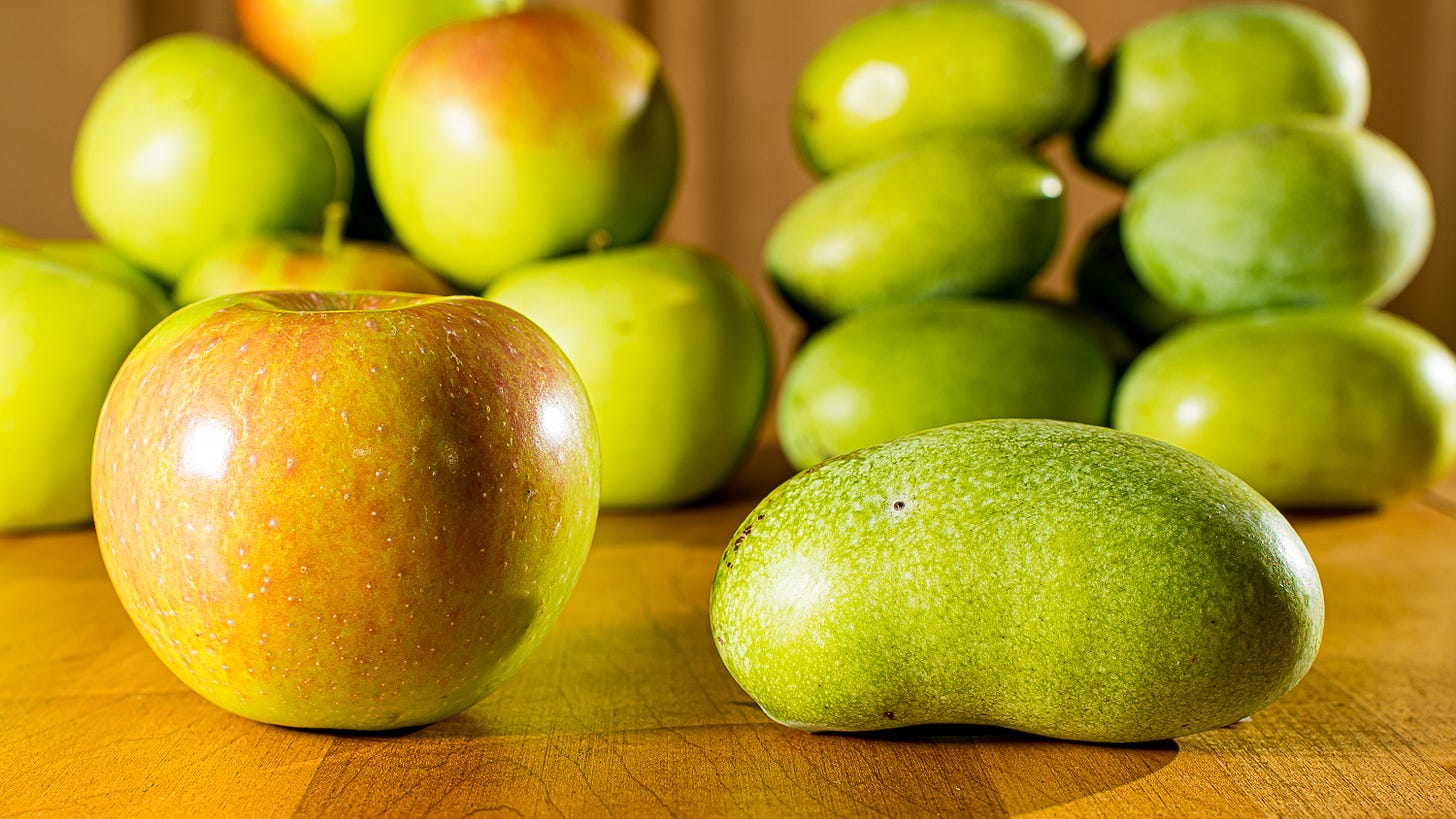
Since I learned of this tree and acquired a deep appreciation for its fruit, I have sought it out in my forest adventures. I have hiked through most of the range of this species — there are other pawpaw species in the deep south, but only A. triloba is found throughout the eastern deciduous forest — and became very familiar with where to find it.
Pawpaw is a small understory tree of lower, moist forest slopes and bottomland forests along creeks and rivers. If you have experience with tropical trees, you will instantly see the tropical features of this tree: broad, soft foliage with a pronounced drip tip (a long tip that sheds water) and smooth leaf margins with no teeth. Its position in the forest understory is characteristic of many trees in tropical forests. It has odd, deep red flowers, pollinated by flies and beetles. The flowers have a sulfurous odor of meat.
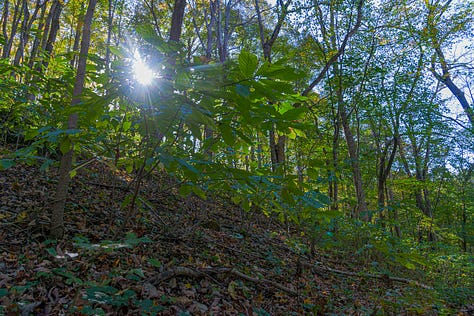
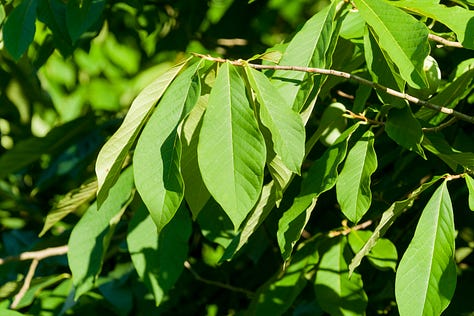
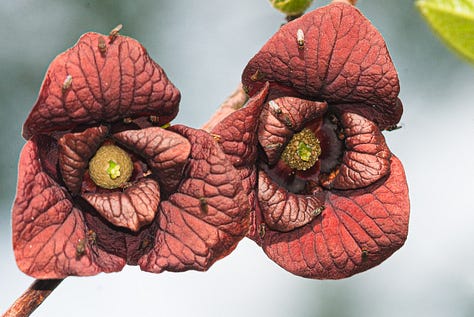
Pawpaw is found in patches like in the picture above. If you are seeking some lovely, refreshing fruit on a warm autumn day, you may be out of luck: a patch of pawpaw trees is almost always a single clone, each tree genetically identical to the others, all connected by a common root system. Like most trees, pawpaw is self-infertile and can only produce fruit by mating with a genetically different tree. So, these large patches often bear no fruit. If you dig up one of these trees and plant it near an unrelated tree, you will get an abundance of fruit.
I keep two pawpaw trees in my back yard, both transplanted from the wild. They each bear an astonishing bounty of fruit every year. Here is a photo of one of my trees in autumn foliage. I get a half bushel of lovely fruit each year.
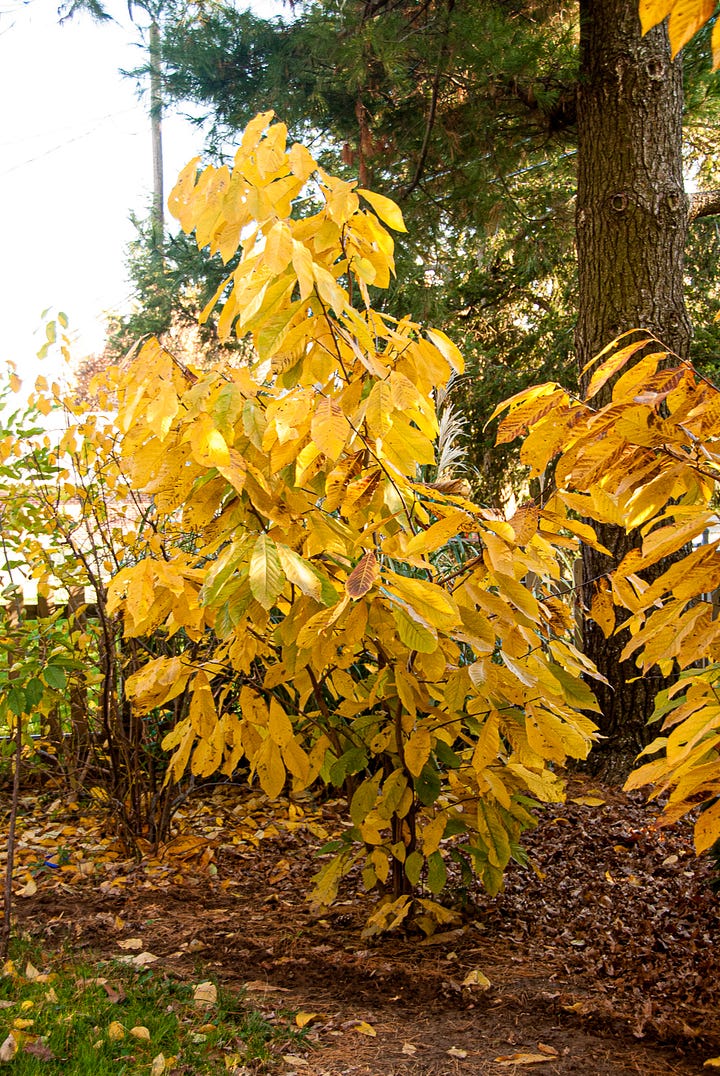
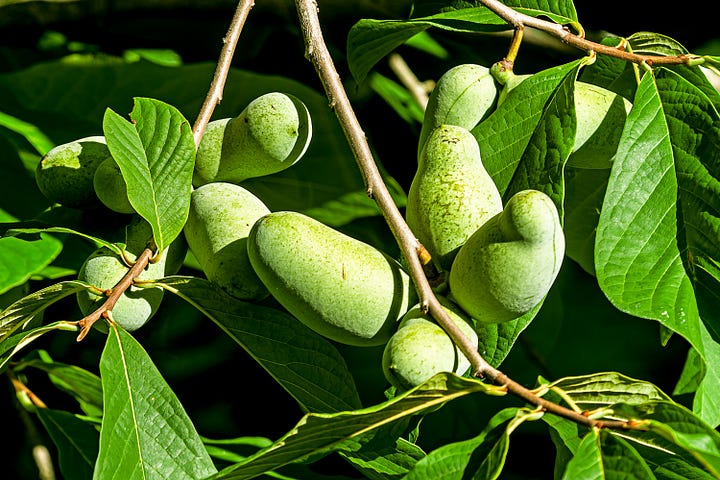
Now we arrive at the mystery of pawpaw. It is a common native tree that produces abundant, delicious fruit. It is easy to grow, is readily pollinated by flies and beetles, and has few pests or pathogens. So why isn’t every back yard and orchard full of these trees? I can think of several reasons.
Some people simply don’t like the flavor, texture and odor. The soft, custardy texture, the intense sweetness with a hint of bitterness or sulfur, and a pungent smell discourage some people from enjoying it. Anyone who has lived in the tropics instantly recognizes that these are the characteristics of many tropical fruits, but not of temperate fruits. Ask people at a pawpaw festival about the fruits, and about 1/3 of them don’t care for the fruit. My own kids did not like the fruit for the same reasons, but sure did like the cake and ice cream I made for them from our backyard trees.
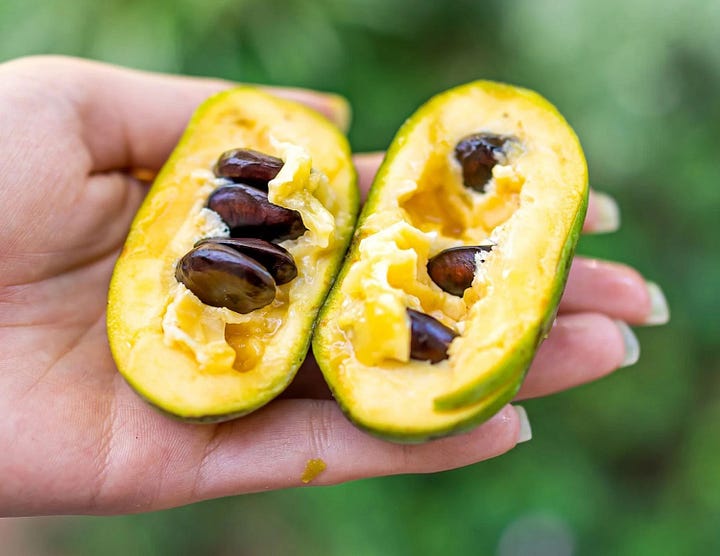
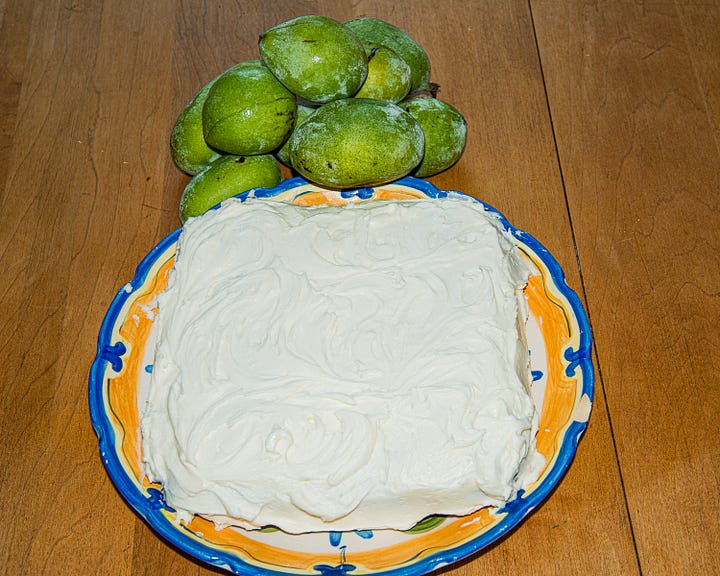
Some people fear the fruits because of a reputation for toxicity. It is true that, like other fruits in this family, pawpaws contain a chemical called annonacin that is a neurotoxin. However, I know of no reports of annonacin toxicity from pawpaws in the scientific literature. The US Food and Drug Administration has said that they do not know of any evidence that pawpaws are unsafe to eat. Many plants, of course, contain chemicals that are toxic in large doses but are safe to eat in quantities that people normally consume.
The chef and culinary historian Michael Twitty has said that European settlers regarded pawpaw as fit only for Negroes and Indians and therefore left them alone. There is certainly some truth to this: pawpaws were often found around slave quarters. Africans from the tropics would have been vary familiar with fruits like pawpaw and would have prized them over many cultivated fruits. And we know that most eastern Native Americans love this fruit and both forage for and cultivate it. There are many trees whose distribution can only be understood if we realize that native people are agriculturists, not passive foragers. I have no doubt that the broad distribution of our pawpaw is a result of the efforts of Native Americans to cultivate and spread the tree widely. We need, then, to accept that there is more than a hint of racism in the shunning of pawpaw by settlers, though some, including George Washington, loved to eat chilled pawpaw fruits.
Finally, we come to the problems of handling this delicate fruit. Pawpaw fruits mature in late summer and must be picked at the peak of ripeness. The fruits don’t change color like a peach or banana might, but remain green. A good sense of smell and a gentle touch allows the grower to pick the fruits when they are just right. But then, the fruit begins to deteriorate quickly and begin to rot in a few days. You can, though, hold them in the refrigerator for up to a month, and the pulp freezes quite well.
Many people despair of making pawpaw orchards make economic sense because of this very short season. But I wonder. Many fruits such as avocado, peach, and banana, are very delicate, ripen quickly, and spoil quickly. Why are they commercially viable when pawpaws are not? I think it comes down to breeding and selection. There were attempts to cultivate pawpaws in the early 20th century, but these failed.
Now we are in a new era of interest in pawpaws. When I began teaching forestry, most of my students, even those from Appalachia, had never heard of, let alone eaten, pawpaw. There were no fruits to be had farmer’s markets. Things began to change in recent years. Suddenly pawpaws are all the rage. There are dozens of pawpaw festivals, fruits are showing up at some farmers markets, and we even have local breweries making pawpaw beer. A small soda company, Ale-8-One (yes, it’s a pun) is introducing an Ale-8-One pawpaw drink in August.
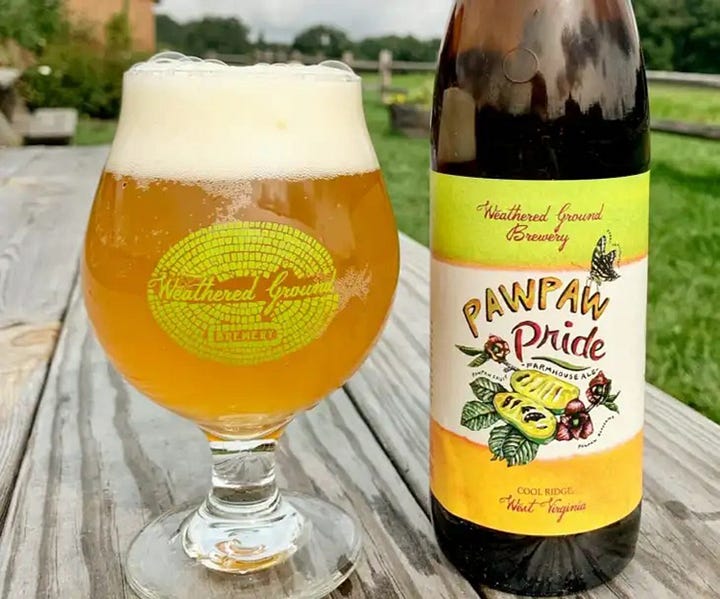
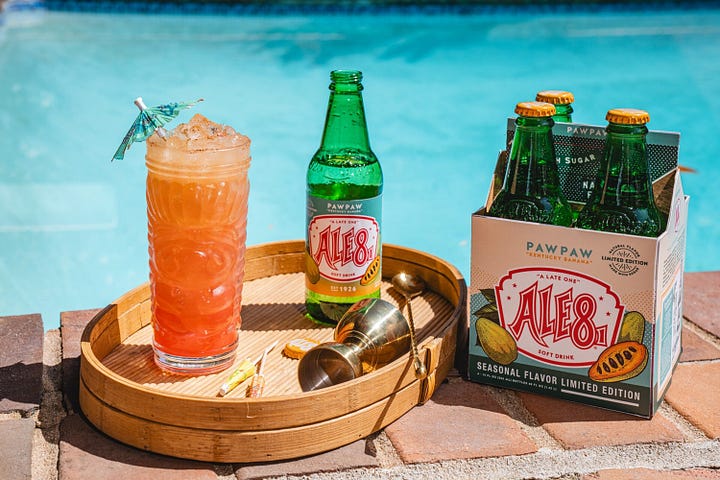
Why the sudden interest? Several things come to mind, aside from the overall broadening of the American diet. Most important, I think, is the establishment of a vigorous pawpaw breeding and selection program at Kentucky State University (KSU), headed by Dr. Kirk Popper. For wild fruits to be practical for orchard production, there needs to be a process of selection - finding the best fruit among wild trees - and breeding - combining the traits of the best fruit by hybridizing them. This process is underway at KSU and is making progress. Bear in mind that creating new crops from wild plants is a slow process. We have been breeding and selecting most fruit trees for thousands of years. I am optimistic that this process will eventually succeed, but not for some time.
The other source of interest is the large number of farmers and hobbyists who have been selecting pawpaws for their own groves. Notable among these growers is Neil Peterson, who has been working to improve pawpaws on his own farm for many decades. Peterson has the advantage of being a trained plant geneticist, though the pawpaw work has been his hobby, not his work, until recently. There are hundreds of other people selecting and improving pawpaws. There is probably a pawpaw grower near you - there is even one in the Netherlands.
I am writing this now, in July. My hope is that you will become curious enough about pawpaws to seek out some pawpaws near you late this summer. Pawpaw is our largest native fruit and, in my view, the equal of any other fruit in the world. Try one!

Thanks for the post, Tom quite informative. I started one from a seed I preserved several winters ago from a small grove in north eastern Oklahoma. It’s about five feet tall now. Do I understand correctly that it will not bear fruit.? I do have a sand plum and cherry tree within several meters.
Thanks for stopping by a couple of my tree-related notes/musings which led me here. I’ve wanted to try a paw paw since about age 3 due to a favorite song on a Burl Ives record. I’ve certainly travelled “yonder” but not way way yonder enough to I guess. You have me most intrigued and I will find one soon I hope!
if I remember correctly, wasn’t Baloo the Bear (a favorite Character) all about paw paw?